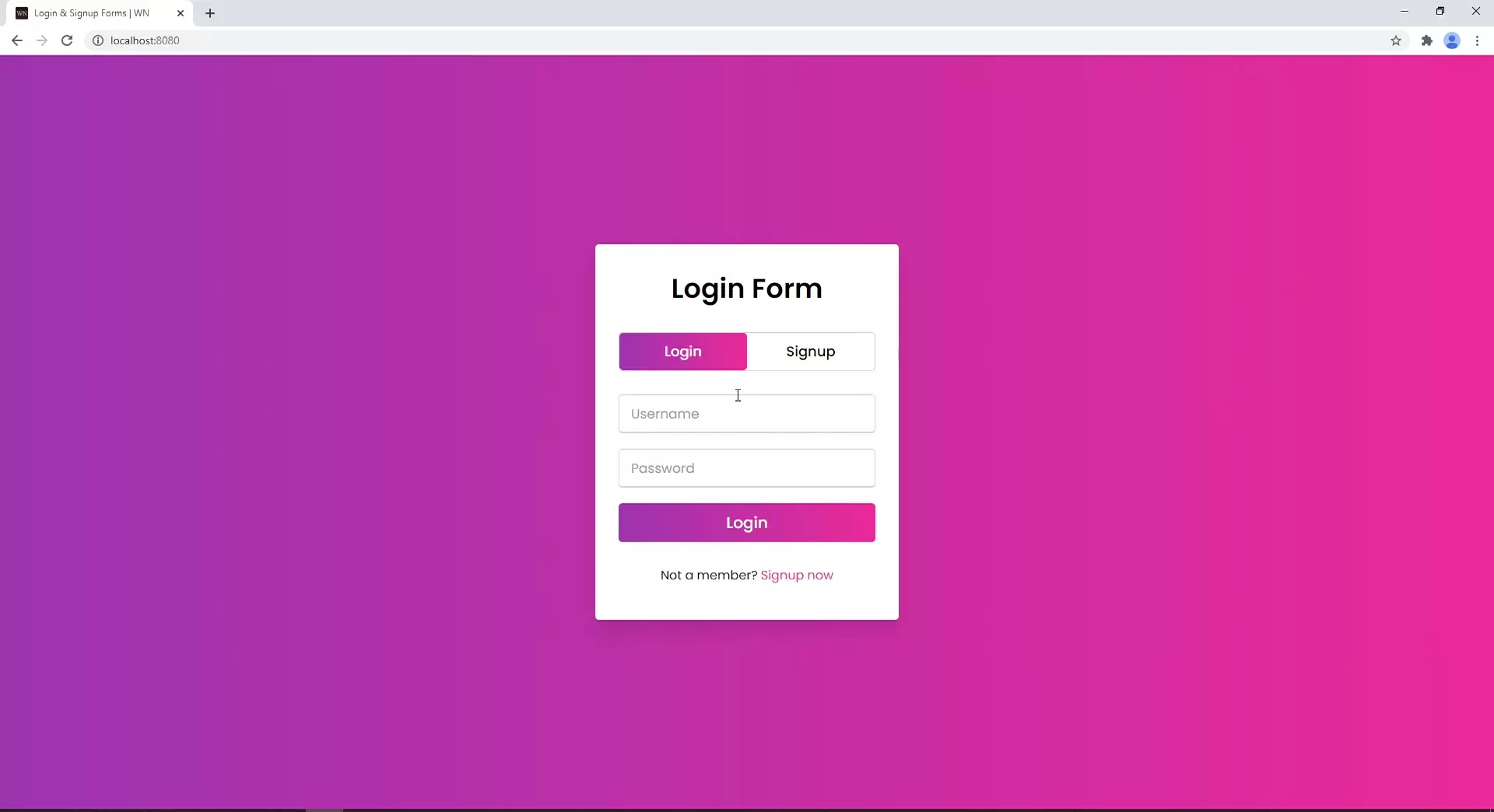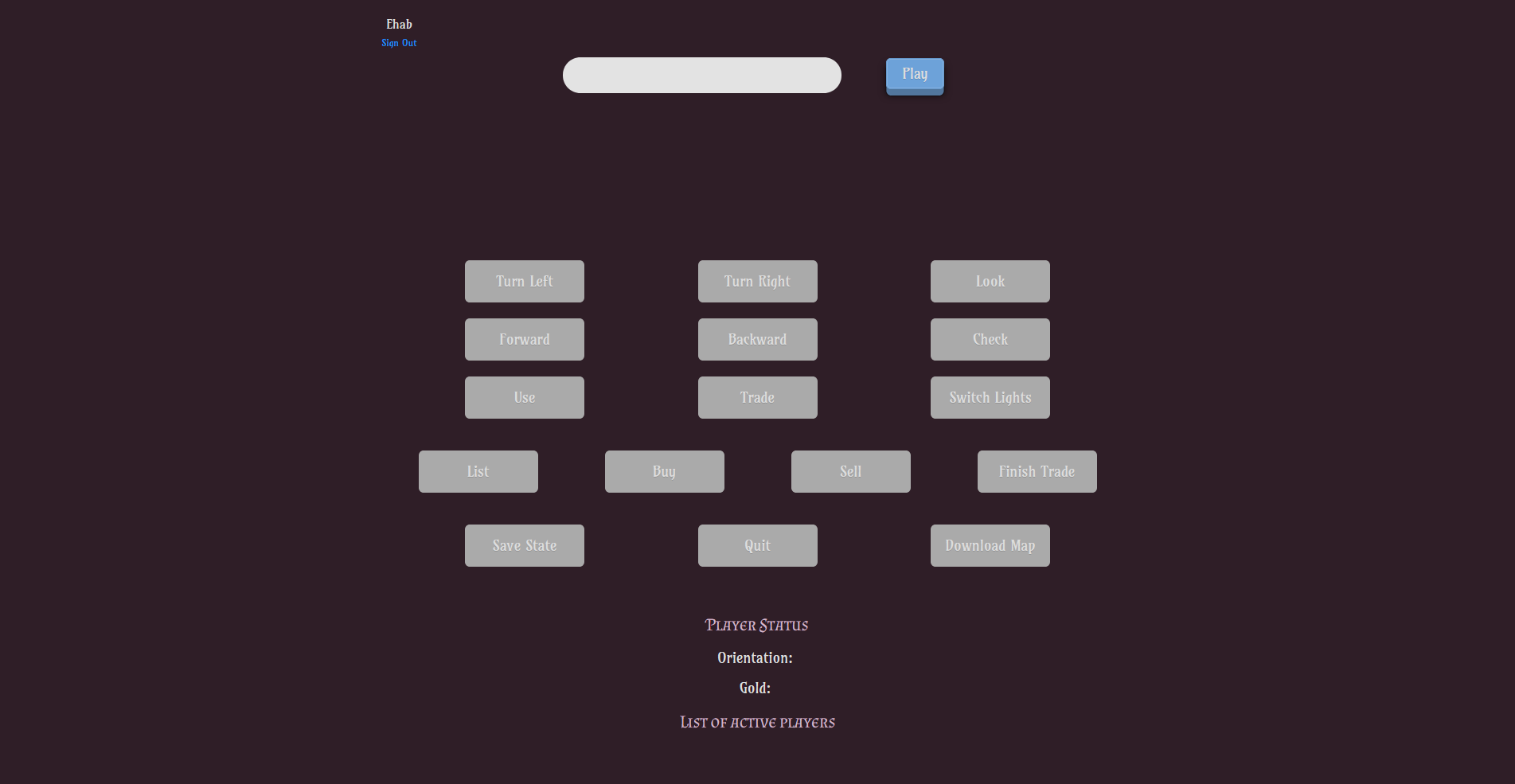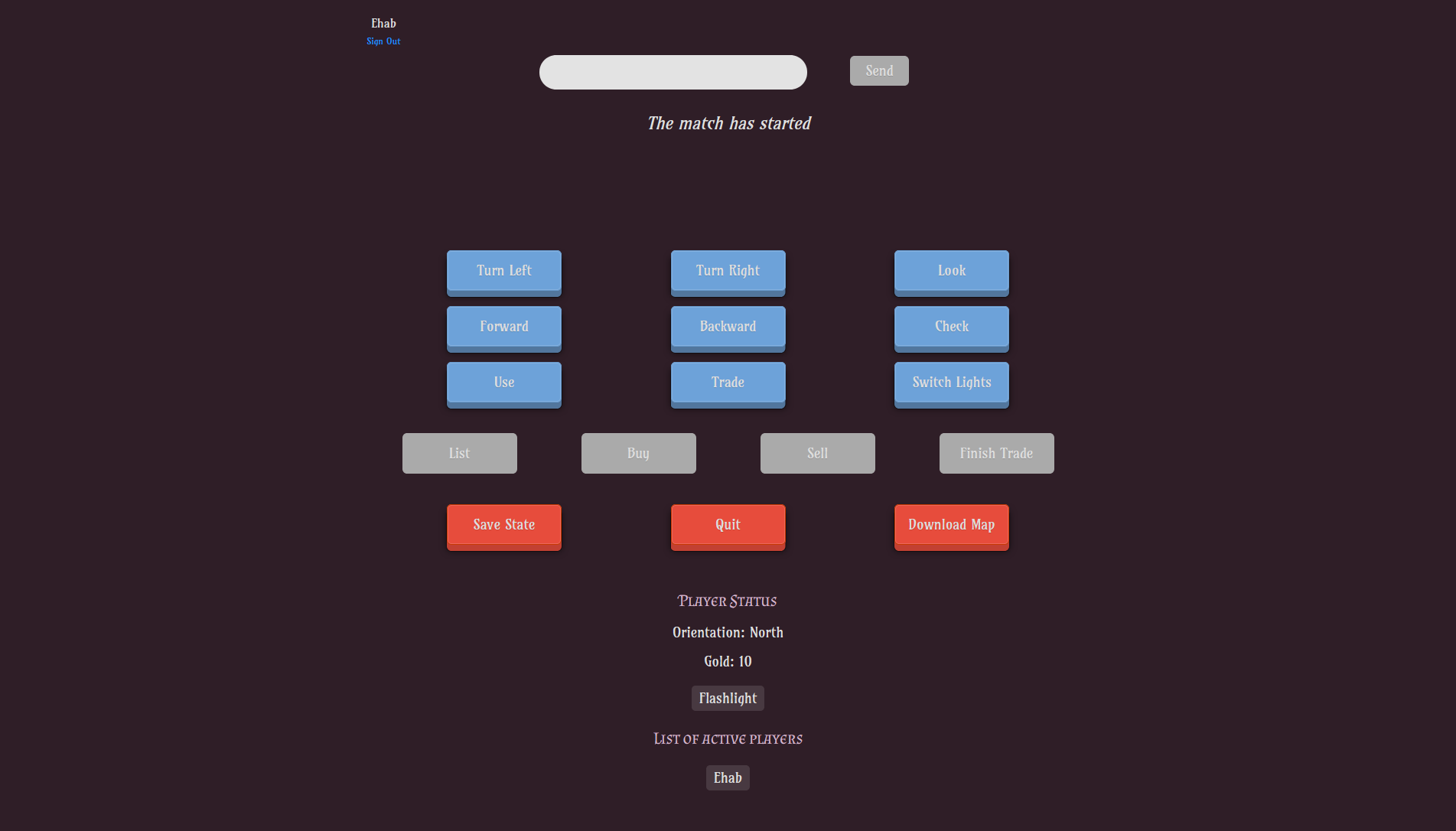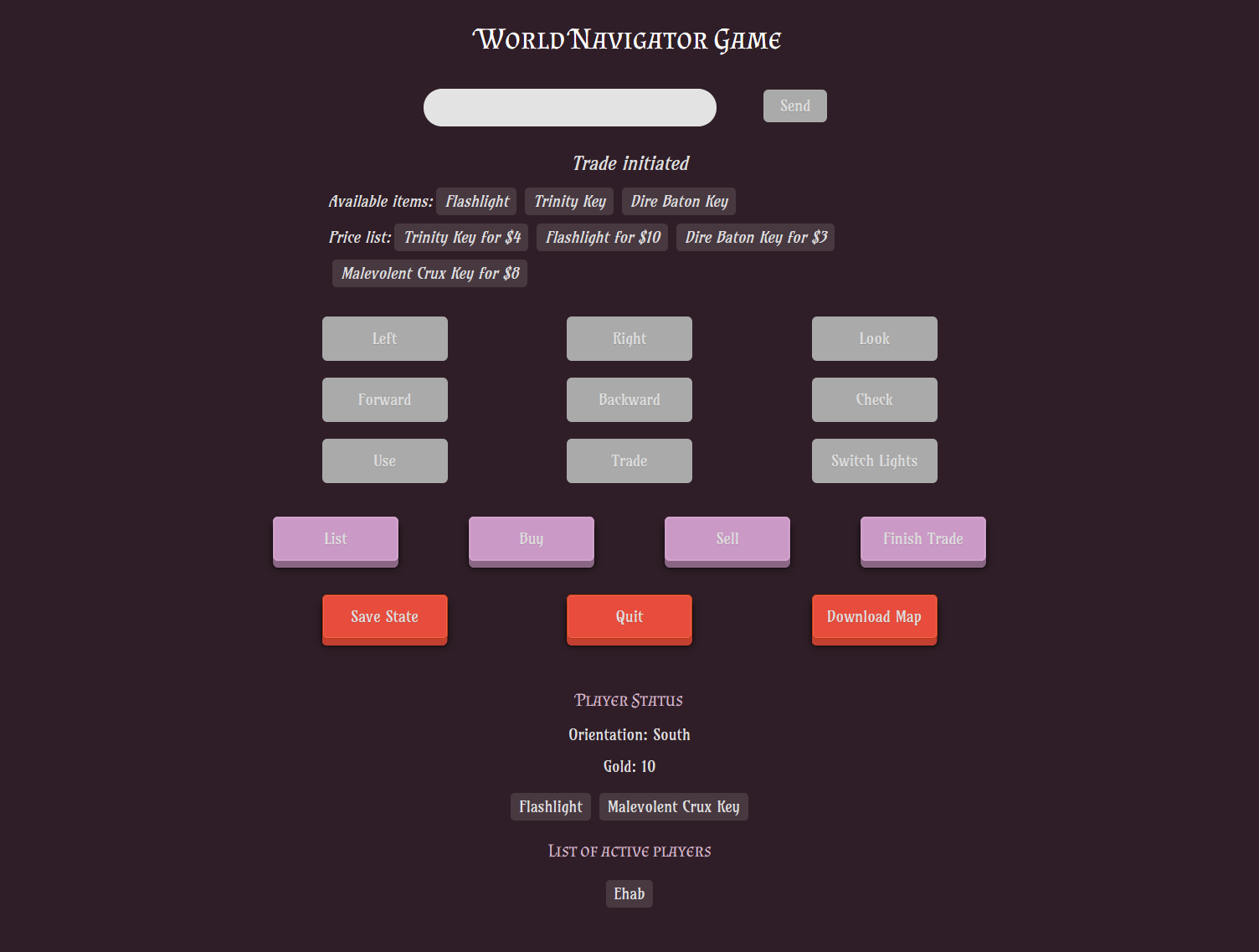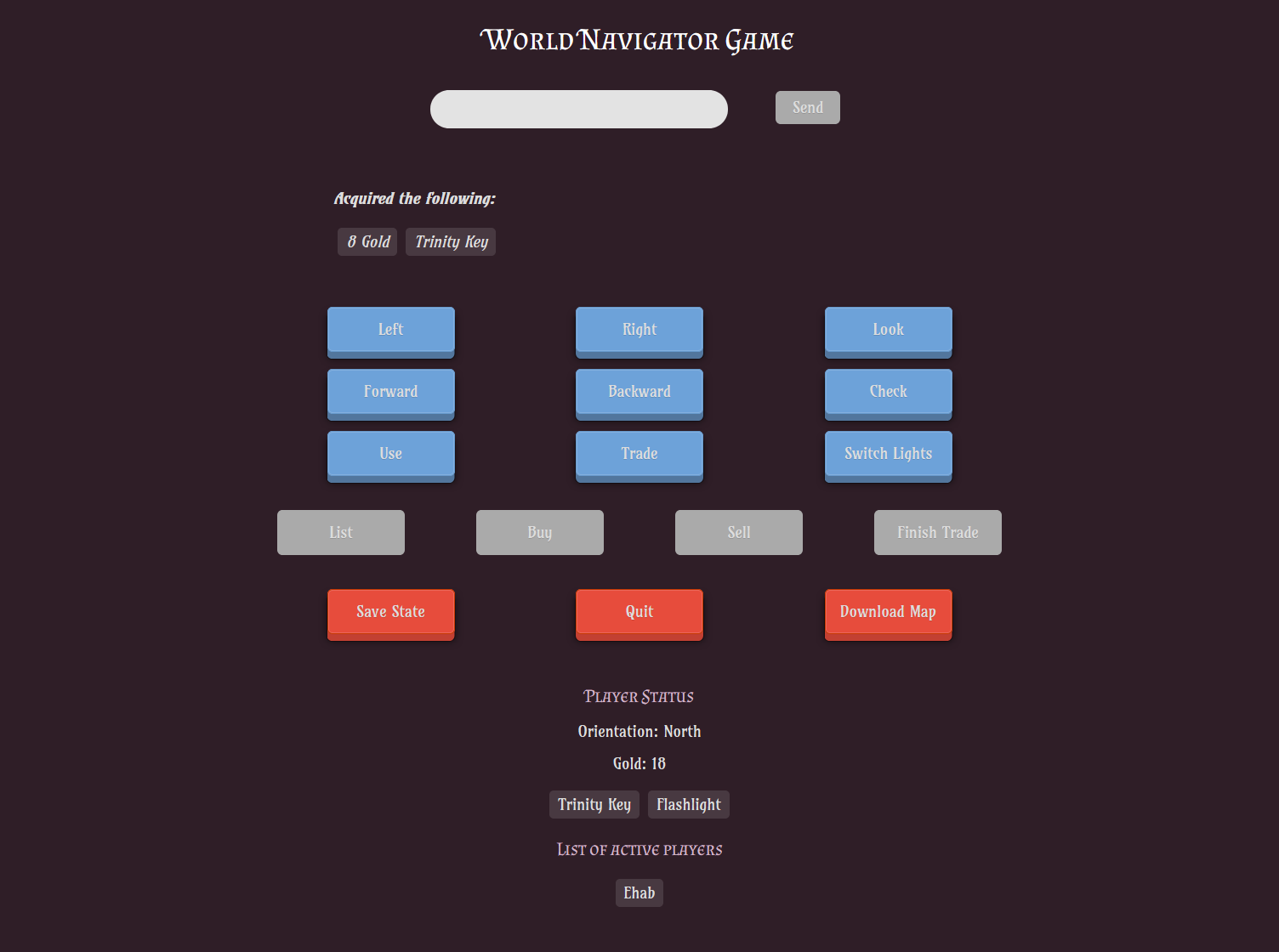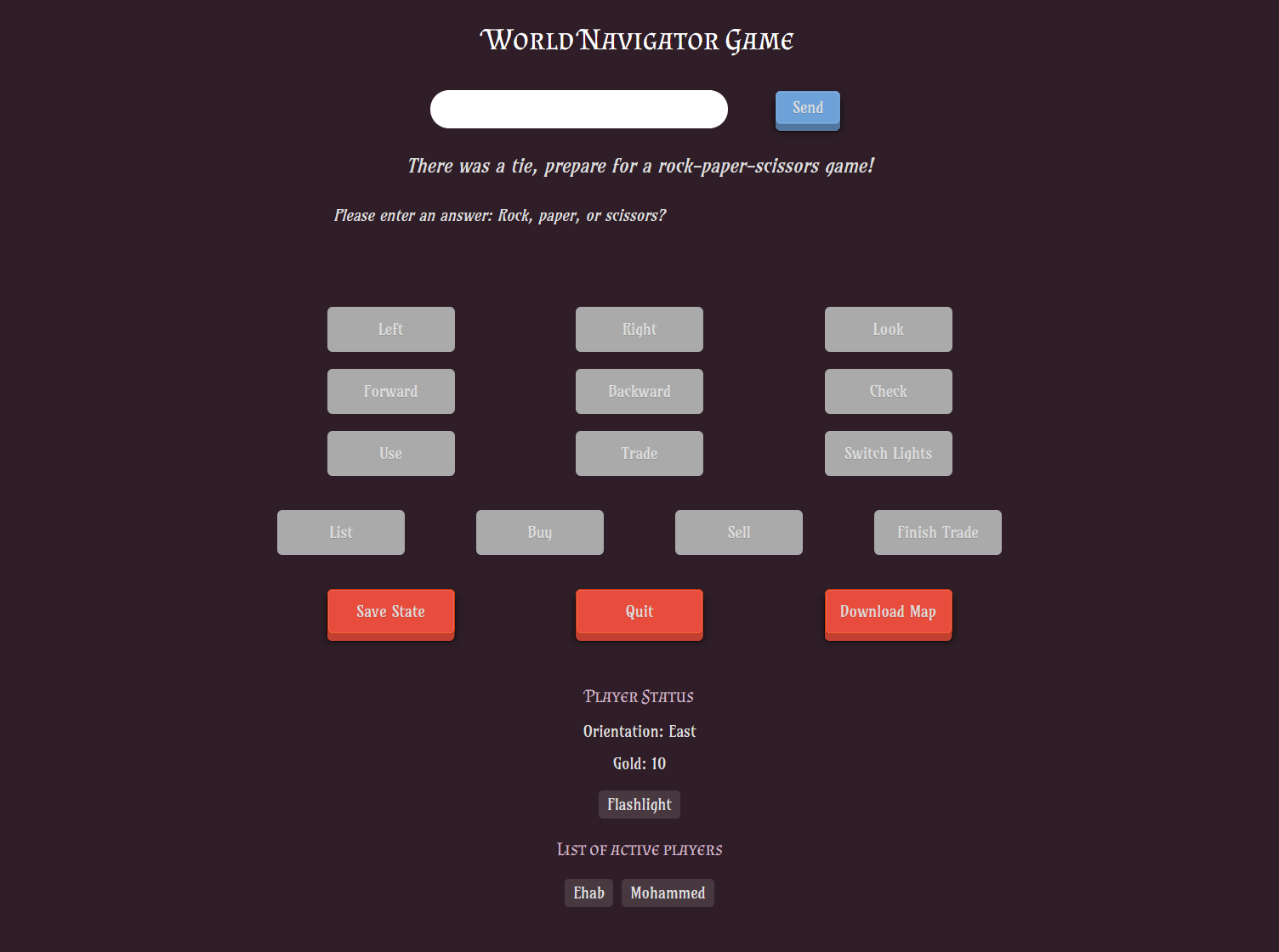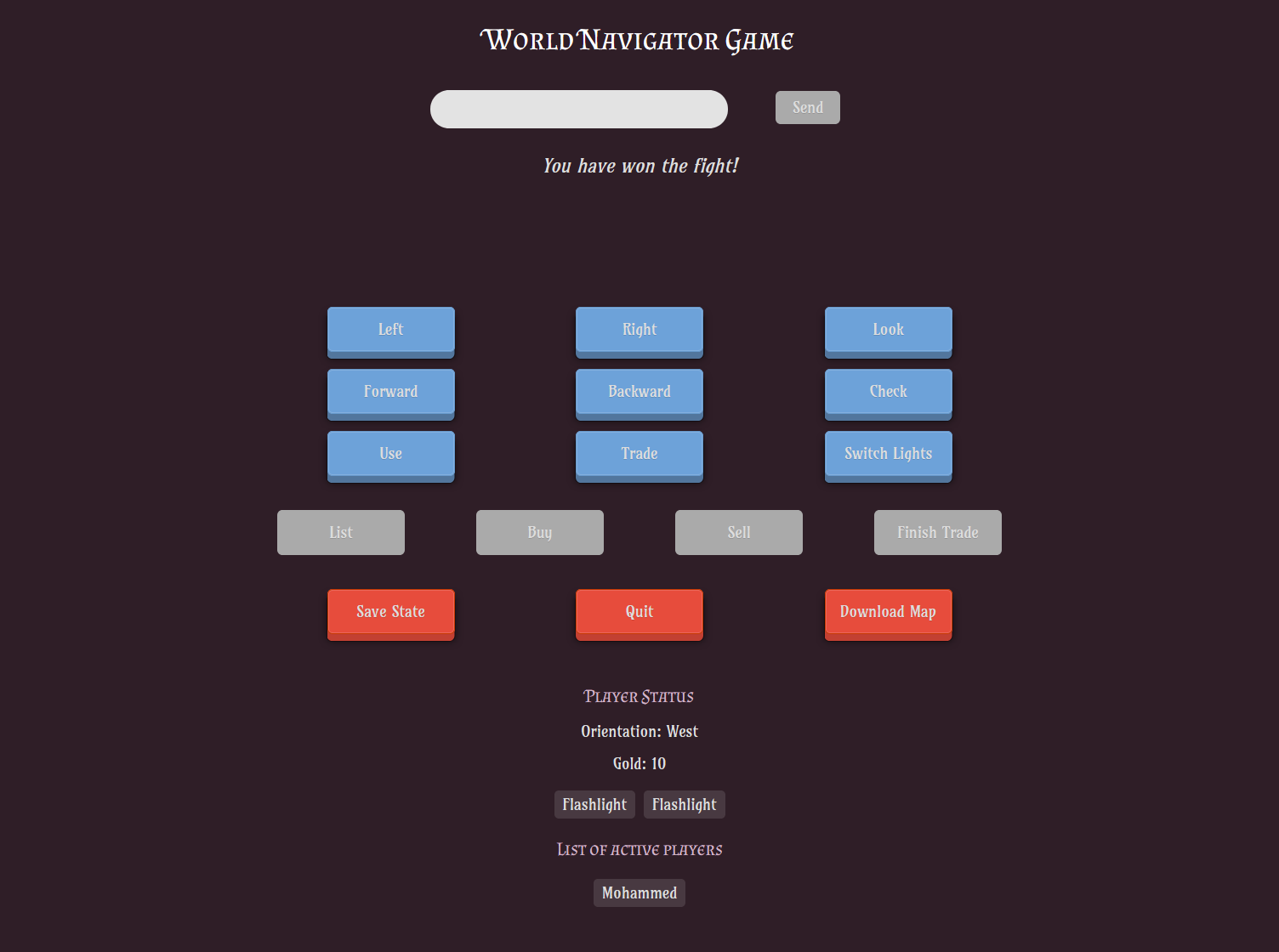This rendition of the World Navigator game is made web-based, online, and between multiple people. In theory, there is no limit to the number of players, since the map is generated on the fly when the match is started. This version also includes a website with a MongoDB database that stores the users' login information.
When navigating to the game website, you are greeted with a login/sign-up form.
After you sign-up and login, you are redirected to the match page.
You click play to register the user in a match.
When the button is clicked again (now displays ready instead of play), then the client notifies the server that the player is ready to play.
When all players are ready, the map is generated, and the match is started.
The JavaScript in the website has several responsibilities:
- Opens the WebSocket and communicates with the server.
- Sends user requests in an appropriate format.
- Dynamically loads content to display to user.
- Requests an updated Player Status when a command that modifies the status is sent.
- Permits only valid operations to be executed.
- Listens to the click events for all buttons and items.
Sign-up and login process:
Here are a few screenshots in different stages of the game:
Here is a scenario for a fight between two players (notice how the player list changes):
Figure 7: Multiple Players in the Same Match

An example of a Download Map command with 1 player in a 3x3 grid:
{
"rooms": [
{
"east": {
"locked": false,
"mapSite": "Door",
"roomID": 1,
"otherRoomID": 2,
"key": "Lich Ornament"
},
"south": {
"locked": false,
"mapSite": "Door",
"roomID": 1,
"otherRoomID": 4,
"key": "Sunshard"
},
"lightswitch": {
"hasLights": true,
"lightsOn": true
},
"north": {
"hiddenKey": "",
"mapSite": "Painting"
},
"west": {
"hiddenKey": "Sunshard",
"mapSite": "Painting"
},
"id": 1
},
{
"east": {
"hiddenKey": "Lich Ornament",
"mapSite": "Mirror"
},
"south": {
"locked": true,
"mapSite": "Door",
"roomID": 2,
"otherRoomID": 5,
"key": "Lich Ornament"
},
"lightswitch": {
"hasLights": true,
"lightsOn": false
},
"north": {
"hiddenKey": "Lich Ornament",
"mapSite": "Painting"
},
"west": {
"locked": false,
"mapSite": "Door",
"roomID": 2,
"otherRoomID": 1,
"key": "Lich Ornament"
},
"id": 2
},
{
"east": {
"hiddenKey": "Lich Ornament",
"mapSite": "Mirror"
},
"south": {
"hiddenKey": "Lich Ornament",
"mapSite": "Painting"
},
"lightswitch": {
"hasLights": true,
"lightsOn": false
},
"north": {
"locked": false,
"mapSite": "Door",
"roomID": 4,
"otherRoomID": 1,
"key": "Sunshard"
},
"west": {
"loot": {
"gold": 0,
"items": []
},
"locked": true,
"mapSite": "Chest",
"key": "Sunshard"
},
"id": 4
},
{
"east": {
"locked": false,
"mapSite": "Door",
"roomID": 5,
"otherRoomID": 9,
"key": "Desolation Harp"
},
"south": {
"hiddenKey": "",
"mapSite": "Painting"
},
"lightswitch": {
"hasLights": true,
"lightsOn": false
},
"north": {
"locked": true,
"mapSite": "Door",
"roomID": 5,
"otherRoomID": 2,
"key": "Lich Ornament"
},
"west": {
"mapSite": "Seller",
"items": [
{
"name": "Desolation Harp",
"type": "Key"
},
{
"name": "Lich Ornament",
"type": "Key"
},
{
"name": "Flashlight",
"type": "Flashlight"
}
],
"priceList": [
{
"price": 15,
"name": "Desolation Harp Key"
},
{
"price": 5,
"name": "Lich Ornament Key"
},
{
"price": 13,
"name": "Sunshard Key"
},
{
"price": 10,
"name": "Flashlight"
}
]
},
"id": 5
},
{
"east": {
"mapSite": "wall"
},
"south": {
"mapSite": "wall"
},
"lightswitch": {
"hasLights": true,
"lightsOn": false
},
"north": {
"mapSite": "wall"
},
"west": {
"mapSite": "wall"
},
"id": 9
}
],
"mapConfiguration": {
"gold": 10,
"time": 540,
"endRoomID": 9,
"items": [
{
"name": "Flashlight",
"type": "Flashlight"
}
],
"startRoomsID": [
4
]
}
}The generation of the map is not purely random, it has some logic to it. The generated map starts with N number of rooms, where N is the number of players. Then a random path is generated, this path is split into levels, and you have to unlock the door at the end of a level to go to the next one. The key to unlock a said door, is placed randomly along this generated path. At the end of each path at the last level, there is a door that when opened the player wins.
After all the paths are generated for each player, a Breadth First Search (BFS) is performed from all the generated rooms at once, then for every empty direction in the room, a randomly generated MapSite is placed. If that MapSite is a door, then that opens a path to another room on the other side.
For the game to be fun, there must be many open doors that lead to dead-ends and distract the player. So, I made the doors have a probability of 50% when generating a MapSite with it being locked only 25% of the time. The rest of the 50% is split evenly between the Mirror, Painting, Wall, Chest, and Seller with 10% each.
This generation logic guarantees that there 100% exists a solution to the maze, while also not making it easy to beat.
Every little detail is also generated based on some probability in its respective class, which can be edited to hone the generator or bias it toward a certain outcome.
Looking at the ChestGenerator class, where we can potentially generate an infinite amount of items, depending on the probabilities:
private static final int PROBABILITY = 100;
private static final int ITEM_PROBABILITY = 40;
private static final int FLASHLIGHT_PROBABILITY = 20;
...
private JSONArray getItemsList() {
JSONArray itemsList = new JSONArray();
int chance = random.nextInt(PROBABILITY);
while (chance < ITEM_PROBABILITY) {
itemsList.put(getItemJson());
chance = random.nextInt(PROBABILITY);
}
return itemsList;
}
private JSONObject getItemJson() {
int chance = random.nextInt(PROBABILITY);
if (chance < FLASHLIGHT_PROBABILITY) {
return ItemGenerator.getFlashlightJson();
} else {
return ItemGenerator.getKeyJson(randomNameGenerator.getRandomName());
}
}A difficulty can also be defined which results in worse probabilities for certain items, less time, and just having a plain harder game. For example, by changing the difficulty we can make it more probable for a room to have no lights:
private boolean hasLights() {
int chance = random.nextInt(MAXIMUM_DIFFICULTY);
return chance < MAXIMUM_DIFFICULTY - difficulty + MINIMUM_DIFFICULTY;
}This changes the probability of having lights in a room from 100% (at difficulty of 1) to 10% (at difficulty of 10).
These configurations can be edited by implementing the MapConfiguration interface and passing it to the MapGenerator, or when using DefaultMapConfiguration the configurations can be customized using the builder.
Since the generated map is in Json format, it can be saved, modified, and used later without much effort. This is especially convenient if a randomly generated map was particularly fun!
When implementing the various game class, I made sure to make it easy to add new stuff (items, commands, functionality, MapSites... etc).
The different player commands were implemented using the Command Pattern (see the report).
This means that adding a new command means you only have to create a new class and implement a certain interface Command or ItemCommand.
The items on the other hand, are stored in the ItemManager as Map<String, Item> where a unique name is used.
In the Item interface:
default String getUniqueName() {
return (getName() + " " + getType()).trim();
}This guarantees that all names for all items are unique. When querying an item (to use, buy, or sell), that unique name is also used. The alternative does not make sense, for example, "Use Dragon Skull" is ambiguous, but "Use Dragon Skull Key" is clear, especially from the point of view of the player.
Related to the items, is the actual usage of them. Items cannot define how the player uses them, it is not their responsibility, and they don't have access to the player anyway.
So a UseItemVisitor was used to define how the player can use an item.
Since ItemManager takes Item, the addition of new items requires no modification at all.
The new item type would need to implement Item and its "use" defined in UseItemVisitor.
The MapSites follow the same formula. In fact, there are 7 interfaces for the MapSites and when interacting with them, the highest abstraction possible is used.
For example, in the look() method, they are interacted with only as MapSite.
While in the checkAhead() method, Checkable is used instead. The same logic applies to Lockable, Lootable, and Hangable.
This is seen clearly in the Player class. It literally does not use any concrete MapSite class.
The use of CheckVisitor and UseItemVisitor made this possible.
public String look() {
...
return mapSite.look();
}
public Response checkAhead() {
Checkable checkable = (Checkable) getMapSiteAhead();
return checkable.accept(checkVisitor);
}The game is played normally like the CLI version except for buttons instead of manually writing the commands.
In fact, the same Interpreter for the CLI was used, with some modifications, to execute incoming commands.
You can also click on the items to select them to execute "use", "sell", or "buy" commands.
There is also an option to save the current state of the map (in Json) for the current player or even the original map itself!
When a player enters a new room, a MatchListener is fired, which tells the match that the player has moved from room X to room Y.
The match then moves the player and checks (synchronously) if the room is already occupied.
If it is then a fight ensues. To get input from the user to break the tie, a BlockingDeque is defined in PlayerController.
This BlockingDeque acts as a buffer between the Server and the Match.
The fighting logic was also made very customizable.
The ConflictResolver class uses the long calculateScore(PlayerController) method defined in ScoreCalculator interface to calculate each player’s score to determine the winner.
If there is a tie then PlayerController breakTie(PlayerController, PlayerController) method in TieBreaker interface can be used to implement whatever tie breaking mini-game (Rock-paper-scissors was used here).
Both of these interfaces can be used to implement custom logic, without changing anything, whether for calculating the score used to determine the winner or the tiebreaker in case of equal scores.
After a user sends a request to the server (using the WebSocket connection), it is caught by the MatchController with it's respective mapping.
There are 4 types of messages supported so far:
- Join message: registers the user in a match
- Ready message: marks the player as ready to play.
- Map message: sends the map being played in Json format.
- Command message: executes the requested command in the game.
These messages can be clearly seen in the MatchController class.
@MessageMapping("/secured/match/join")
@SendToUser("/queue/match/message")
public ResponseMessage joinMatch(Principal user) {
...
}
@MessageMapping("/secured/match/ready")
@SendToUser("/queue/match/message")
public ResponseMessage readyToPlay(Principal user) {
...
}
@MessageMapping("/secured/match/command")
@SendToUser("/queue/match/command")
public CommandResponse processCommand(@Payload CommandRequest request, Principal user) {
...
}
@MessageMapping("/secured/match/map")
@SendToUser("/queue/match/map")
public MapMessage downloadMap(Principal user) {
...
}Since responses can differ based on the request, I made 6 different types of messages that can be sent to the user (see website.payload.response package)
EventMessage and StateChangeMessage are sent when various events happen (server -> client) instead of the usual (client -> server).
There are 2 types of listeners placed on certain events:
MatchListener and StateListener
The Match class, which is responsible for coordinating the state of the players and the interaction between them, has no access to the commands being executed.
- An
onMovelistener was placed in PlayerController soForwardandBackwardcommands can then trigger the listener to notify the match that a player moved some room to the other. - The match also listens to another event,
onQuitwhich removes the player from the match and drops their items and gold in the room.
The second type of listener is the state listener, which also listens to 2 events:
- A GameEvent -
onGameEvent - A StateChange event -
onStateChange
The GameEvent is used by the Match to notify the player of a certain event.
While the State tracks the current state the player is in which can restrict some actions or even end the game.
Both of these events are then reported to the user by sending either an EventMessage, or a StateChangeMessage using:
simpMessagingTemplate.convertAndSendToUser(user, PATH, payload);See mazegame.events package and website.services.match package for more information.
DefaultMapConfiguration: the default configuration for generating a map. (implemented the MapConfiguration interface)ItemGenerator: contains static methods that generate an item (in Json) given its name.MapConfiguration: an interface that defines the properties of the generator (Number of levels, steps per level, difficulty, and size of the map).MapGenerator: the main class for this package. It generates the all the rooms and mapSites (except the ones generated inPathGenerator)MapSiteLocation: A data structure that stores the location of a MapSite (room ID and Direction).PathGenerator: generates a random path with a certain number of steps and levels. Then places a key within the path that unlocks a door at the end of a level.PositionManager: a class responsible for checking the validity of a certain move (such a move is within the limits of the map)RandomNameGenerator: a class that returns a random name.RoomGenerator: responsible for creating and managing rooms.WeightedRandom: given weights, this class returns a random number with the probability of the given weights.WeightedItemRandomizer: a generic class that returns a random Object with certain weights.
ChestGeneratorDoorGeneratorHangableGeneratorKeyHolderGeneratorMapSiteGenerator(interface)SellerGeneratorWallGenerator
This package contains random generators that generate Json for all MapSites with some given probabilities.
Direction: Enum class to identify and operate on the orientation of the player. (NORTH,EAST,SOUTH,WEST)PlayerController: the interface forMatchand various events.MazeMap: stores the map configurationsResponse: a data type that stores the result of an operation in the form of a message (String) and aJsonEncodable. (Chest,Player... etc)
CommandItemCommandActionValidityCheckerValidityResponse- Rest of the commands
This package includes all the implemented commands, along with the "checker"
classes to verify the validity of using the commands in the current state.
It also defines the interfaces used for commands implementation.
So adding another command is as simple as creating a new class and implementing either Command or ItemCommand.
EventHandler: handles listeners and the triggering of events.GameEvent: Enum with four eventsSTART_MATCH,SENDING_PLAYER_LIST,TIE_FIGHT,REQUESTING_INPUT.MatchListener: interface to listen for Match related events, namely: a move (forward/backward) and quitting.State: Enum class for the state of the game. (EXPLORE,TRADE,FIGHT,WON,LOST)StateListener: interface to listen forGameEventandStatechanges.
InvalidUseOfItem: thrown when the player tries to use an item in a place where it cannot be used, like using the wrong key or using a key with noLockableobject in-front of the player.ItemNotFoundException: thrown when a requested item does not exist.MapSiteLockedException: thrown when trying to open a locked object.NoLightsException: thrown when trying to toggle lights if the room does not have lights.NotEnoughGoldException: thrown if the player tries to buy items but does not have enough gold.
ItemManager: manages item retrieval and removal.Item: an interface used to defineItemclassesKeyFlashlight
ItemVisitor: an interface to define visitors for variousItem(s)
Includes various map sites, and their helper interfaces: AbstractHangable, AbstractLockable, Checkable, CheckableVisitor, Chest, DarkMapSite, Door, Hangable, Lock, Lockable, Loot, MapSite, Mirror, Painting, Seller, SerializeableMapSite.
Player-centric classes, like, CheckVisitor, Inventory, Player, Position, UseItemVisitor.
Includes LightSwitch, NoLightSwitch (special case), and Room classes.
TradeHandler used to handle the communication between the player and the seller and to verify the validity of the trade.
GameParser: a utility class to parse the game.ItemParser: parses the items (KeyandFlashlight) in the gameMapSiteParser: parses the various map sites in the game.
Encoder: an interface visitor that defines which objects a serializer must implement for the serializer to work correctly.JsonEncodable: an interface that defines which objects can be Json serializable. It contains the single methodString encodeUsing(Encoder encoder);JsonEncoder: an implementation of Encoder that encodes objects to a Json format.JsonSerializer: given a PlayerController, the sole public methodString serializeGameState(PlayerController playerController)can be used to save the state of the game.
Application: the main program that runs the server and the WebSocket.
WebConfig: containsaddResourceHandlerswhich configures the location of static data. (image, css, js... etc)WebSocketConfig: configures the endpoints, message broker, and STOMP to be used over the WebSocket.
AppController: handles HTTP requests (mainly,/andmatch). Makes sure the user is logged in.CsrfTokenController: generates a CSRF token for the user.MatchController: handles all the WebSocket requests.
ERole: an Enum that contains the different roles a user can have (ROLE_USER,ROLE_MODERATOR,ROLE_ADMIN)Role: the model for theRoleused in MongoDB.User: the model for theUserused in MongoDB.
CommandRequest: contains a singleStringfieldcommandused for sending commands.RequestMessage: contains a twoStringfields,typeandcontentused for everything else.
BasicMessage: an abstract class that is used as a basic template for response messages.CommandResponse: contains the command issued, the message, and any data that was requested.EventMessage: contains the name of the event that happened (see GameEvent Enum)InvalidMessage: contains the error message for an invalid requestMapMessage: contains the Json of the generated mapResponseMessage: a class that contains the response to a general request.StateChangeMessage: contains the new state of the player (see State Enum)
Contains two interfaces that extend MongoRepository, these methods define the supported operations.
For example:
public interface UserRepository extends MongoRepository<User, String> {
Optional<User> findByUsernameIgnoreCase(String username);
Boolean existsByUsernameIgnoreCase(String username);
}RoleRepository on the other hand only has a findByName(ERole name) method.
WebSecurityConfig: configures the authentication and guarantees that access of users.WebSocketSecurityConfig: makes sure that the user is authenticated in all secure WebSocket.
The most important method is the configure method:
protected void configure(HttpSecurity http) throws Exception {
http.authorizeRequests()
.antMatchers("/match", "/csrf", "/secured/**").authenticated()
.anyRequest().permitAll()
.and()
.formLogin()
.loginPage("/").permitAll()
.usernameParameter("username")
.defaultSuccessUrl("/match")
.permitAll()
.and()
.logout().logoutSuccessUrl("/").permitAll();
}This allows / but blocks access to /match, /csrf, and /secured/** unless authorized.
MatchService: a service betweenMatchControllerand the other match-related classes.UserDetailsImpl: a data structure that contains the user's authentication information.UserDetailsServiceImpl: contains a single methodpublic UserDetails loadUserByUsername(String username)that returns an instance ofUserDetailsImpl.
ConflictResolver: a class that determines the winner in a conflict between players. This determination is based on the implemented ScoreCalculator and eventually TieBreaker interfaces.FightManager: a class that handles the fighting between players in a room.RockPaperScissors: a simple implementation of TieBreaker that breaks ties using a game of Rock-Paper-Scissors.ScoreCalculator: an interface with a single methodlong calculateScore(PlayerController playerController)used to calculate a players score when fighting.SimpleScoreCalculator: a score calculator that calculates the score by adding the gold, number of flashlights x 2, number of keys x 10.TieBreaker: an interface with a single methodPlayerController breakTie(PlayerController playerController1, PlayerController playerController2)used to break ties and return the winner.
Match: notifies the winners and losers of the game. This class manages the whole match and connects various components together.MatchCreator: keep track of everything pre-game, like the players, their usernames, and whether they are ready to play or not. It generates the map and creates aMatchinstance when all players are ready.MatchStartListener: a listener with methodvoid onMatchStart(Collection<PlayerController> playerControllers)that is triggered when all the players are ready and the game starts.MovementManager: responsible for moving players from room X to room Y.
Interpreter: contains a single public methodResponse execute(String command)that executes one action at a time and returns the response.PlayerConfig: a data structure that contains the username, and theMatchCreatorinstance of a player.
css/button.css: the stylesheet for the buttons.css/index.css: the stylesheet forindex.html.css/match.css: the stylesheet formatch.html.favicon/: contains the favicon of the website in several formats.js/FileSaver.js: used to download the Json of the map.js/match.js: the JavaScript that handles all the events (clicks and typing) inmatch.htmland communicates with the server through WebSockets.
index.html: the HTML that is served to the user when they navigate to/, contains the login and sign-up forms.match.html: the HTML that is served to the user when they navigate to/match. This is the webpage for the actual game.
